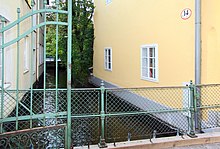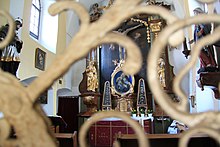Bürgerspital Baden near Vienna
The Bürgerspital in Baden near Vienna was a residential and nursing home that was rebuilt in the 16th century and was set up in the building that still exists today, Heiligenkreuzer Gasse 4, until the middle of the 19th century.
term
Hospitals were among the most important social institutions of the Middle Ages and early modern times . These were not hospitals - for them the term “ military hospital ” was common - but homes for the accommodation of old and disabled people who could not earn their living through their own work or cover from savings. Often they required constant maintenance. The word Bürgerspital indicates that this institution was intended for impoverished and ailing citizens.
history
The part of the building known as "Anna-Mühle" is mentioned in documents in 1312 and 1317, but it is assumed that the building existed as early as the 13th century. Earlier names are Spital-, Bruck-, Ochsen- or Wilhelm-Mühle.
A citizens' hospital already existed in Baden at the end of the Middle Ages, but the building was apparently destroyed during the Turkish invasion in 1529 , and its financial basis was lost in the economic crisis of those years. The judges and council of Baden tried to rebuild. On June 4, 1537, the city received the approval of the Passau episcopal official to sell Baden church property and to use 70 guilders of the proceeds for the reconstruction of the citizen hospital and for the welfare of the poor. A solution to the problem was found in 1542 through the generous donation of the knight Gerwig Auer von Herrenkirchen .
Gerwig Auer von Herrenkirchen decided to dedicate a substantial part of his fortune to the Baden Citizens Hospital, thus supporting the community in its efforts to rebuild this institution. He donated his farm in Baden with a garden and the mill, which was driven by the Baden mill stream , a property that he had bought in 1525. Presumably because of the status of its owner, the property was given the status of a Freihof or noblemen's seat , although it was still subject to compulsory service for the Cistercian Abbey of Heiligenkreuz . The letter also stipulated that the judge and council had to appoint a hospital master who was responsible for looking after the inmates and managing the foundation's assets, as well as settling the alms received , and at Christmas every year for judges and council in the presence of the pastor will be checked. Arms could be taken up on a personal basis or for a limited time. The inmates had the duty to pray for the salvation of all founders, but especially for Gerwig Auer von Herrenkirchen and his two wives. Gerwig Auer von Herrenkirchen died in 1551; he was buried in the parish church of Baden. The goods of the Augustinian Hermit Monastery in Baden, which were left to the Citizens Hospital from 1545, were to be returned in 1583.
In 1701, the chapel, restored after the destruction of the Turkish invasion of 1683, was given a bell in this citizen's hospital. To mark the 200th anniversary of the founding in 1742, a large memorial plaque with a chronogram was placed in the first courtyard of the building under city judge Georg Reinwald . In 1745 the St. Anna Chapel was re-consecrated by Auxiliary Bishop Josef Heinrich Breitenbucher.
A commission set up by Maria Theresia in 1746 described the Baden Citizens Hospital as follows: Through this institution twelve people - six men and six women - received accommodation, care, food, drinks and clothing. It consists of the hospital building with a chapel consecrated to Saint Anne , a mill with three corridors, a brewery and a garden, all of which are subject to compulsory service for the Heiligenkreuz monastery. In 1753 the Spitalsmühle was sold, which resulted in difficulties because it could hardly be separated from the hospital building. The tract on Heiligenkreuzer Gasse remained the citizens' hospital of the city of Baden. In 1853 the properties were assigned to the municipality.
The citizen's hospital was closed in the second half of the 19th century, and the building was expanded into a residential building. In 1895 the city moved the citizens 'hospital to the Straßer'sche citizens' supply house (Neustiftgasse), and in 1905 the district poor house was finally founded (Wiener Straße).
Building description
Citizens Hospital
Located on the outside of the curved Heiligenkreuzer Gasse, the building of the former citizens' hospital forms an important, picturesque motif for the Baden cityscape. This building is two-story, a three-story tower structure with a four-sided pyramid roof , the corners of which are bevelled, rises above the segment arched gate. There is a small sheet metal hood at the top of the tower structure. In 1836, the current tower structure was built in place of the previous chapel tower during a renovation. In 1895 there was another renewal, with the inscription Bürger-Spital donated 1542 above the gate .
During the renovation of the building in 1979, the polychromed stone statue from the 17th century, located on the left in front of the gate at the level of the first floor in a round arched niche, was also subjected to a thorough restoration. This shows Saint Elisabeth of Thuringia handing alms to a cripple .
St. Anne's Chapel
The Anna Chapel, accessible from the entrance hall, is a single-nave room with barrel vaults and stitch caps. On the first floor, above the entrance hall, there is a chapel against a basket arch open oratorio with Gothic stellar vault and birnförmigem rib profile. The altar is made of wood, marbled . Above the tabernacle there is a half-length figure of the holy mother Anna with her daughter Maria , a high relief made of wax, polychromed , in an oval frame under glass. It is an interesting work from the second half of the 18th century. The altar has a pilaster structure with curved beams , in the middle a polychrome wooden crucifix against a painted background . In front of the pilasters there are statues of St. Mary and the Apostle John on volutes , parts of the crucifixion group , so to speak , also from the second half of the 18th century. Between the side pilasters and the central relief, pyramid-shaped baroque glass containers rise on both sides , with relics in the lower part and votive symbols in the upper part . On the side walls there are statues on consoles , works from the 18th century, on the left that of St. John Nepomuk and on the right that of Our Lady . The other numerous figures and pictures in the chapel are of no artistic value. There used to be a polychrome wooden trinity group in the small sacristy , also from the 18th century; In 1978, after a thorough restoration, it was loaned to the parish church, where it found a worthy place above the entrance to the Kreuzkapelle.
Old Catholic parish in Baden
The St. Annakapelle is a place of worship of the Old Catholic Church in Austria . The Old Catholics in Baden have been organized in a diaspora congregation since the 1930s, which is assigned to the parish of Sankt Salvator (Vienna) for pastoral care. The old Catholic diaspora community of Baden regularly takes part in the Long Night of the Churches .
See also
literature
- Johannes Ressel: The Anna chapel in the former citizen hospital . In: -: Churches and chapels, religious memorial columns and signposts in Baden near Vienna. A contribution to history, local history and art history. 2nd, improved and enlarged edition. Grasl, Baden 1982, ISBN 3-85098-131-2 , p. 124 ff.
- Viktor Wallner : Houses, people and stories - a Baden anecdotal walk . Society of Friends of Baden, Baden 2002, OBV .
- Helmuth Feigl : The “Bürgerspital zu Baden” valid . In: Landlords and community in old Baden. In: Yearbook for regional studies of Lower Austria. New series 66–68, 2000–2002, Association for Regional Studies of Lower Austria, St. Pölten 2006, OBV , pp. 168–171.
- Peter Aichinger-Rosenberger among others: Lower Austria south of the Danube. Band 1: A to L . Dehio-Handbuch , Die Kunstdenkmäler Österreichs, topographic monuments inventory. Berger, Horn / Vienna 2003, ISBN 3-85028-364-X .
- Rudolf Maurer: The Citizens Hospital. (PDF). Catalog sheets of the Rollettmuseum Baden, No. 8, Rollettmuseum, Baden 2013, ISBN 978-3-901951-08-4 .
Individual evidence
- ^ A b Feigl: The valid "Bürgerspital zu Baden". P. 169.
- ↑ Bürgerspital, Annamühle and Annakapelle ( Memento of the original from February 21, 2014 in the Internet Archive ) Info: The archive link has been inserted automatically and has not yet been checked. Please check the original and archive link according to the instructions and then remove this notice. Tourism Baden, accessed on February 4, 2014.
- ↑ Feigl: The valid "Bürgerspital zu Baden". P. 168.
- ^ A b Feigl: The valid "Bürgerspital zu Baden". P. 170.
- ↑ a b c d e Ressel: The Anna chapel in the former citizen hospital. P. 125.
- ↑ Feigl: The valid "Bürgerspital zu Baden". P. 171.
- ^ Wallner: Houses, people and stories. P. 110.
- ^ Aichinger-Rosenberger: Lower Austria south of the Danube. P. 173.
- ^ Ressel: The Anna chapel in the former citizen hospital. P. 126.
- ↑ Religious communities in Baden, municipality of Baden, accessed on February 5, 2014.
- ^ Christian Halama-Blankenstein, Altkatholiken in Österreich , Vienna 2004, p. 699.
- ↑ Old Catholics in Baden Old Catholic Diaspora Community Baden, accessed on February 5, 2014.
- ↑ Long Night of the Churches 2014. ( Memento from February 9, 2015 in the Internet Archive ) Old Catholic Diaspora Congregation Baden, accessed on February 9, 2015.
Remarks
- ↑ Duke Friedrich August the Strong , Elector of Saxony, who converted to Catholicism in 1697 and thus cleared the way to the royal crown of Poland, is said to have changed his denomination in the gardens behind the citizens' hospital. - Wallner: Houses, People and Stories. P. 110.
Web links
- Peter Smola: Citizens Hospital. In: badenfotos.com , accessed on May 7, 2011.
Coordinates: 48 ° 0 ′ 25.4 ″ N , 16 ° 13 ′ 52.5 ″ E



